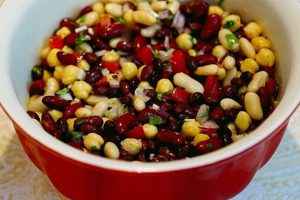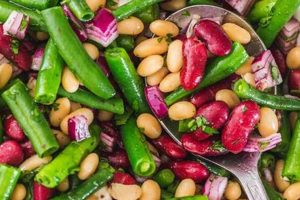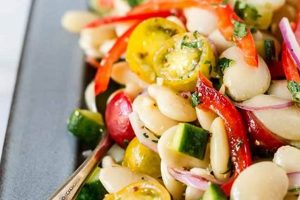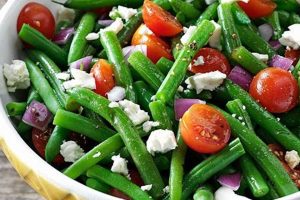Refreshing and flavorful, chilled green bean salads offer a versatile culinary canvas. These dishes typically combine blanched or steamed green beans with complementary ingredients like other vegetables, herbs, cheeses, nuts, and a vibrant dressing. A classic example might include tender green beans tossed with slivered almonds, crumbled feta cheese, red onion, and a lemon-herb vinaigrette.
These salads provide a healthy and satisfying option, particularly during warmer months. Green beans are a good source of vitamins and fiber, and the customizable nature of these recipes allows for the incorporation of other nutrient-rich ingredients. Historically, preserving and pickling vegetables was a common practice, and while these salads are not pickled, the concept of preparing vegetables for later consumption aligns with this tradition. The refreshing nature of these salads makes them a welcome addition to picnics, potlucks, and barbecues.
The following sections will delve deeper into specific variations, exploring different flavor profiles and preparation techniques for creating delicious green bean salads. Topics covered will include selecting the best green beans, achieving the perfect blanch, crafting complementary dressings, and exploring diverse ingredient combinations.
Tips for Exceptional Green Bean Salads
Achieving optimal flavor and texture in a green bean salad requires attention to detail throughout the preparation process. These tips offer guidance for creating a dish that is both delicious and visually appealing.
Tip 1: Blanch Green Beans Properly: Blanching enhances color and tenderness while maintaining a crisp texture. Submerge beans in boiling water briefly, then immediately transfer to an ice bath to stop the cooking process. This crucial step prevents overcooking and preserves a vibrant green hue.
Tip 2: Select Fresh, Crisp Beans: Choose green beans that are firm, vibrant in color, and free from blemishes. Avoid beans that appear limp or dull.
Tip 3: Balance Flavors in the Dressing: A well-balanced dressing is essential. Consider the acidity, sweetness, and saltiness, adjusting ingredients to complement the other components of the salad. A touch of Dijon mustard or honey can add complexity.
Tip 4: Embrace Variety with Ingredients: Explore different textures and flavors by incorporating complementary ingredients like toasted nuts, dried cranberries, crumbled cheese, or thinly sliced red onion.
Tip 5: Chill Thoroughly Before Serving: Allow the salad to chill for at least 30 minutes before serving. This allows the flavors to meld and enhances the refreshing quality of the dish.
Tip 6: Don’t Overcrowd the Salad: Avoid overcrowding the bowl, which can bruise the beans and make the salad less appealing. A larger serving bowl allows for even distribution of ingredients and dressing.
Tip 7: Consider Marinating the Beans: Marinating the blanched green beans in a portion of the dressing can further enhance their flavor.
By following these tips, one can elevate a simple green bean salad to a culinary masterpiece. The combination of fresh ingredients, a well-balanced dressing, and proper preparation techniques yields a dish that is both healthy and satisfying.
The following section will offer a collection of curated recipes that showcase the versatility and delicious potential of green bean salads.
1. Fresh, High-Quality Green Beans
Fresh, high-quality green beans form the foundation of a successful cold green bean salad. Their inherent crisp texture and vibrant flavor are essential for a refreshing and palatable dish. Using subpar beans, such as those that are limp, dull in color, or blemished, compromises the final product. The undesirable characteristics of inferior beans become more pronounced when served cold, impacting both the taste and visual appeal of the salad. Conversely, fresh, crisp beans retain their desirable qualities even after chilling, contributing to a more satisfying culinary experience. For instance, a salad featuring fresh, vibrant green beans tossed with a light vinaigrette and complementary ingredients offers a crisp, refreshing bite. Using older, less vibrant beans would result in a less appealing, potentially mushy, and less flavorful salad.
The importance of bean quality extends beyond mere aesthetics and taste. Fresh beans offer better nutritional value, retaining more vitamins and minerals. They also tend to hold their shape better after blanching, preventing a mushy texture. This is particularly crucial in a cold salad where the beans are not cooked further. One practical application of this understanding is the intentional selection of beans at the peak of freshness. Visiting local farmers’ markets or selecting beans that appear firm and brightly colored in the grocery store can significantly enhance the final dish. Proper storage techniques, such as refrigerating unwashed beans in a perforated plastic bag, also contribute to maintaining their freshness until preparation.
In conclusion, the quality of green beans directly impacts the overall quality of a cold green bean salad. Prioritizing fresh, high-quality beans ensures a more appealing, flavorful, and nutritious final product. This understanding allows for informed ingredient selection and proper handling, ultimately contributing to a more successful and enjoyable culinary outcome.
2. Complementary Flavor Pairings
Complementary flavor pairings significantly elevate cold green bean salad recipes from simple to sophisticated. The inherent vegetal flavor of green beans provides a neutral backdrop, allowing for diverse flavor combinations. Understanding these pairings allows for the creation of balanced and nuanced dishes that appeal to a wider range of palates. The interplay of contrasting yet harmonious flavors adds depth and complexity, transforming the overall sensory experience. For example, the bright acidity of lemon juice balances the earthiness of green beans, while the salty tang of feta cheese provides a contrasting savory element. Alternatively, the nuttiness of toasted almonds complements the green beans’ subtle sweetness, creating a richer flavor profile.
Effective flavor pairings consider not only taste but also texture and aroma. Crunchy elements like toasted nuts or seeds contrast with the tender beans, while fresh herbs provide aromatic complexity. The choice of dressing also plays a critical role in harmonizing flavors. A vinaigrette with Dijon mustard adds a subtle sharpness, while a creamy dressing based on yogurt or buttermilk offers a tangy counterpoint. Further complexity can be achieved by incorporating ingredients like dried cranberries or slivered red onion, which introduce sweet and pungent notes respectively. These layered flavors prevent the salad from becoming monotonous, offering a more engaging and satisfying culinary experience.
In conclusion, successful cold green bean salads depend heavily on carefully considered flavor pairings. The interplay of contrasting tastes, textures, and aromas elevates the dish beyond its basic components. This understanding allows for the creation of balanced, nuanced, and ultimately more enjoyable salads. The practical application of this knowledge empowers culinary creativity, facilitating the development of unique and flavorful dishes tailored to individual preferences and dietary needs.
3. Well-balanced Dressings
Well-balanced dressings are crucial for successful cold green bean salad recipes. The dressing serves not merely as a coating but as an integral component that enhances and unifies the other ingredients. A thoughtfully crafted dressing elevates the overall flavor profile, balancing the inherent vegetal notes of green beans with complementary acidity, sweetness, saltiness, and aromatics. An imbalanced dressing can overwhelm the delicate flavors of the salad, rendering it either too acidic, overly sweet, or bland.
- Acidity
Acidity provides brightness and helps cut through the richness of other ingredients. Lemon juice, vinegar (red wine, white wine, or balsamic), and even citrus zest contribute a refreshing tang. The level of acidity should complement the other flavors without overpowering them. For example, a lemon-herb vinaigrette provides a bright counterpoint to the earthiness of green beans. Too much acidity, however, can make the salad unpleasantly tart.
- Sweetness
A touch of sweetness balances the acidity and adds complexity. Honey, maple syrup, or a pinch of sugar can subtly enhance the overall flavor profile. This sweetness should be restrained, serving to round out the other flavors rather than dominating them. A honey-mustard dressing, for instance, offers a balanced sweet and savory profile. Excessive sweetness, however, can mask the other delicate flavors in the salad.
- Saltiness
Salt enhances the other flavors and brings the dressing into balance. Sea salt, kosher salt, or even a salty cheese like feta or Parmesan contribute necessary saltiness. The amount of salt should be carefully calibrated to avoid over-salting, which can overwhelm the palate. Feta cheese crumbled into the salad, for example, contributes both saltiness and a creamy texture. Over-salting, however, can make the salad unpleasant and mask the subtle flavors of the vegetables.
- Aromatics and Oils
Aromatics, such as fresh herbs, garlic, or shallots, add depth and complexity to the dressing. The type of oil used also influences the overall flavor. Extra virgin olive oil provides a robust flavor, while lighter oils like grapeseed or avocado oil offer a more neutral base. Fresh dill paired with a lemon vinaigrette, for example, provides a bright, herbaceous aroma and flavor. The choice of aromatics and oils should complement the other ingredients without clashing or overpowering them.
By carefully balancing these elements, a dressing transforms a simple cold green bean salad into a more complex and satisfying dish. The dressing harmonizes the flavors of the green beans and other components, creating a cohesive and delicious culinary experience. The interplay of acidity, sweetness, saltiness, and aromatics ensures that no single flavor dominates, resulting in a well-rounded and enjoyable salad.
4. Proper Blanching Techniques
Proper blanching techniques are essential for achieving optimal texture and color in cold green bean salad recipes. Blanching involves briefly submerging green beans in boiling water, followed by immediate immersion in ice water to halt the cooking process. This technique preserves the beans’ vibrant green color, which would otherwise dull with other cooking methods or prolonged exposure to heat. More importantly, blanching ensures a tender-crisp texture, preventing the beans from becoming mushy or overly soft, a critical factor in cold salads where the beans are not cooked further. For instance, blanched green beans retain a pleasant snap, contrasting with other ingredients and enhancing the overall sensory experience. Conversely, overcooked beans become limp and unappetizing, detracting from the salad’s appeal.
The precise timing of the blanching process is crucial. Under-blanching results in raw-tasting beans with an unpleasant toughness, while over-blanching leads to mushiness and a loss of vibrant color. Generally, two to three minutes in boiling water suffices for most green beans. Factors like bean thickness and desired texture may necessitate slight adjustments to this timing. The ice bath is equally important; it immediately stops the cooking process, preventing carryover cooking that could lead to over-softening. This rapid cooling also helps set the vibrant green color, ensuring an appealing presentation. A practical example of this precision is evident when comparing a salad made with properly blanched beansvibrant, crisp, and flavorfulto one made with over-blanched beansdull, mushy, and less palatable.
In summary, proper blanching techniques significantly impact the final quality of cold green bean salads. This process preserves color, optimizes texture, and enhances overall palatability. Understanding and applying these techniques ensures a more appealing and enjoyable culinary outcome. The difference between a vibrant, crisp salad and a dull, mushy one often hinges on the precise execution of this seemingly simple but crucial step.
5. Creative Ingredient Combinations
Creative ingredient combinations transform cold green bean salad recipes from predictable to exceptional. While green beans offer a pleasant, neutral base, their flavor profile benefits significantly from thoughtful pairings. Exploring diverse ingredients unlocks a wide range of flavor profiles and textural contrasts, adding depth and complexity to the final dish. This exploration moves beyond standard additions, encouraging culinary innovation and personalized flavor experiences.
- Textural Contrasts
Incorporating ingredients with varying textures creates a more engaging sensory experience. Crunchy elements, such as toasted nuts (almonds, pecans, walnuts), seeds (sunflower, pumpkin), or croutons, provide a counterpoint to the tender green beans. This interplay of textures prevents the salad from feeling monotonous, adding a dynamic element to each bite. For example, the snap of a green bean followed by the crunch of a toasted almond offers a more satisfying and memorable experience than a salad consisting solely of soft textures.
- Flavor Dimensions
Expanding beyond basic savory flavors adds depth and complexity. Sweet elements, like dried cranberries, chopped dates, or segments of orange, contrast with the green beans’ earthiness. Salty components, such as feta cheese, bacon crumbles, or olives, provide a savory counterpoint. Spicy ingredients, like slivered jalapeos or a pinch of red pepper flakes, introduce a welcome heat. The strategic combination of these flavor dimensions creates a more nuanced and balanced salad, appealing to a broader range of palates. For example, a salad combining green beans, feta cheese, cranberries, and toasted pecans offers a complex interplay of sweet, salty, and nutty flavors.
- Aromatic Herbs and Spices
Fresh herbs and spices significantly enhance the aromatic profile of the salad. Dill, mint, parsley, and chives provide bright, herbaceous notes that complement the green beans. Spices like cumin, coriander, or a pinch of smoked paprika introduce warm, earthy undertones. These aromatic additions elevate the sensory experience beyond taste and texture, engaging the sense of smell and creating a more immersive culinary experience. For instance, a salad featuring fresh dill and a lemon vinaigrette offers a refreshing and aromatic contrast to the green beans.
- Unexpected Additions
Moving beyond traditional ingredients can yield surprisingly delicious results. Roasted vegetables, such as sweet potatoes or bell peppers, add depth and sweetness. Grains like quinoa or farro provide a hearty element and textural variation. Fruits like grapes or berries offer a burst of freshness and sweetness. These unexpected additions can transform a simple green bean salad into a more substantial and exciting dish. For example, incorporating roasted sweet potatoes and toasted pepitas adds unexpected sweetness and crunch, transforming the traditional green bean salad into a more complex and satisfying meal.
By thoughtfully combining ingredients that offer contrasting textures, diverse flavors, and aromatic complexity, cold green bean salads transcend the ordinary. These creative combinations elevate the dish from a simple side to a star attraction, offering a more nuanced and satisfying culinary experience. This approach encourages experimentation and personalization, allowing for the creation of unique flavor profiles tailored to individual preferences.
Frequently Asked Questions
This section addresses common inquiries regarding cold green bean salad recipes, offering practical guidance and clarifying potential points of confusion. Understanding these frequently asked questions can empower culinary exploration and ensure successful outcomes.
Question 1: What is the best way to ensure green beans retain their vibrant color after blanching?
An ice bath is crucial. Immediately transferring blanched green beans to ice water stops the cooking process and sets the vibrant green color, preventing dulling.
Question 2: Can frozen green beans be used in these salads?
While fresh green beans are preferred for optimal texture and flavor, frozen beans can be substituted. Thaw and drain them thoroughly before incorporating them into the salad. Blanching may not be necessary, but ensure they are heated through if previously uncooked.
Question 3: How long can a cold green bean salad be stored in the refrigerator?
Properly stored in an airtight container, a cold green bean salad can typically last for three to five days in the refrigerator. However, salads containing ingredients like fresh herbs or cooked proteins may have a shorter shelf life. Always assess the quality of the salad before consuming it after it has been refrigerated.
Question 4: What are some suitable alternatives to traditional vinaigrette-based dressings?
Creamy dressings offer a different flavor profile. Greek yogurt or buttermilk can serve as a base, combined with herbs, spices, and a touch of lemon juice or vinegar for tang. Tahini-based dressings also provide a rich and nutty alternative.
Question 5: How can one prevent a cold green bean salad from becoming watery?
Thoroughly drying the green beans after blanching and washing helps prevent excess moisture. Additionally, salting certain ingredients, like cucumbers or tomatoes, draws out excess water, which can then be discarded before combining them with the green beans and other components.
Question 6: Can these salads be adapted for specific dietary needs, such as vegan or gluten-free diets?
Adaptability is a key strength of these salads. Vegan variations can replace dairy-based ingredients with plant-based alternatives, like vegan feta or a cashew-based creamy dressing. Gluten-free versions simply require ensuring all ingredients, particularly dressings and added proteins, are gluten-free.
By addressing these common queries, potential challenges are mitigated, and the path is cleared for creating delicious and successful cold green bean salads. A clear understanding of these aspects empowers culinary experimentation and ensures consistently satisfying results.
The following section will provide a collection of curated recipes, offering practical examples of these principles in action.
Cold Green Bean Salad Recipes
Cold green bean salad recipes offer a versatile and refreshing culinary canvas. Exploration of this subject has highlighted the importance of fresh, high-quality ingredients, balanced dressings, proper blanching techniques, and creative ingredient combinations. A thorough understanding of these elements allows for the creation of salads that transcend the ordinary, offering complex flavor profiles, engaging textural contrasts, and vibrant visual appeal. From classic combinations to innovative interpretations, the potential for culinary expression within this seemingly simple dish is vast.
The adaptability of cold green bean salad recipes allows for customization to suit individual preferences and dietary needs. Further exploration of flavor pairings, dressing variations, and ingredient combinations promises continued culinary discovery. Ultimately, the enduring appeal of these salads lies in their refreshing simplicity, their capacity for creative expression, and their ability to elevate a simple gathering into a culinary celebration.






